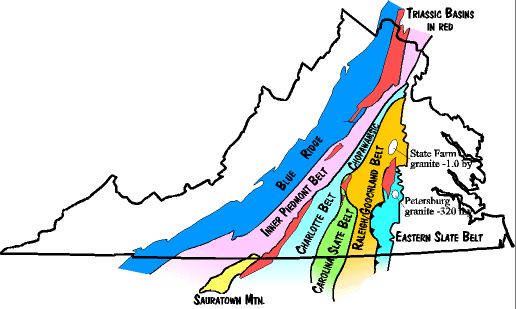 Cross Section
F (Next Cross Section) (Previous Cross Section) (Home) The Chopawamsic and Arvonia Volcanic Arcs Late Cambrian; 540 - 435 mya   But out in the ocean basin things are happening that will affect the Mid-Atlantic in the future. This is one of the more speculative parts of Virginia's history. We know the Chopawamsic arc exists in the Fredricksburg area today (piedmont belt map), but what would make us think it had an origin elsewhere? There are a couple of pieces of evidence.
But out in the ocean basin things are happening that will affect the Mid-Atlantic in the future. This is one of the more speculative parts of Virginia's history. We know the Chopawamsic arc exists in the Fredricksburg area today (piedmont belt map), but what would make us think it had an origin elsewhere? There are a couple of pieces of evidence.The first is that it is difficult, although not impossible, for an active volcano chain and a vast carbonate tidal flat system to exist virtually side by side, if not at the same place at the same time. It is just not parsimonious in a plate tectonic world (see Stage E). For example, a volcanic arc (the Arvonia) when it became active in Virginia in the middle Ordovician helped destroy the carbonate depositional environments. The second evidence is that the Chopawamsic arc is not found alone. Two volcanic arcs, the Chopawamsic and the Arvonia (Stage G) are intimately nested together. Indeed, the Arvonia volcanic arc lies unconformably on top of the Chopawansic. That is, the Chopawamsic arc went through its history, became extinct, and then eroded down to its batholiths. This was followed by a second volcanic arc, the Arvonia, that became active in the viscinity of the extinct Chopawamsic, dumping all its volcanic debris and sediments on top of the Chopawamsic erosion surface. This makes sense when we realize that the Chopawamsic is Middle Cambrian in age, and the Arvonia Ordovician, about 50 million years younger. The Chopawamsic could easily in the time available become extinct and erode. Furthermore, there is good evidence the Arvonia was active when it collided with North America to cause (in part) the Taconic Orogeny so if the extinct Chopawamsic and active Arvonia arcs are nested together then they both came on board (collided with) North America at the same time, middle Ordovician, even though they were not both active at the same time. To this point the evidence is pretty clear, and the argument straight forward. In a plate tectonic world these kind of events are not unusual. The questions are, why and how did the Chopawamsic become extinct? And how did the Arvonia begin? And which way were the respective subduction zones dipping? In this history we are postulating that the Chopawamsic arc died when it collided with a microcontinent (above cross section), and that the Arvonia initiated with a subduction under the microcontinent+eroded Chopawamsic. Evidence and arguments for this scenario are presented in Stage G, and the further details links there. For the time being, we just accept that the extinct middle Cambrian Chopawamsic arc will arrive in North America in the middle Ordovician in the company of the Arvonia. But in fact it is even more complcated than that, as Stage G illustrates.
|